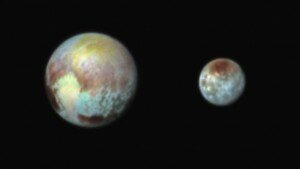 On Tuesday, history will be made and nine years of work will culminate in a special moment for the science and technology communities, as well as the rest of the world.
On Tuesday, history will be made and nine years of work will culminate in a special moment for the science and technology communities, as well as the rest of the world.
which has traveled over three billion miles in the course of nine years, will finally reach Pluto and fly by the planet to capture images the world has never seen before. The tiny dwarf planet (it was actually technically demoted from being a planet in 2006) is the last of the classical nine planets you learned in elementary school to be photographed at such a close range.
These photographs will give scientists a much better of idea about the planet’s relationships with its moons, what the planet is made of, and how large it is. When we call it the Pluto flyby, we really do mean just a flyby. The spacecraft travels at about 31,000 mph. The craft’s quick zip past Pluto will collect astounding amounts of data, if you’re wondering just how cool technology is.
The spacecraft is about as big as a baby grand piano, and carries seven instruments that make thermal maps, check geology, capture interaction with solar wind, and measure atmospheric composition. The mission, and these measurements, are important for a few reasons.
“From a philosophical point of view, it’s the completion of humanity’s first reconnaissance of all the planets in the original solar system, something we started just 50 years ago,” says Joel Parker, director of the Southwest Research Institute’s space science and engineering division. “To me, that’s astounding. Maybe in today’s fast paced world that seems like a long time. But, you know. Space is big. Space is hard.”
As you might imagine, there are plenty of manufacturers, makers, scientists, and technologists who have poured time, effort, money, and experiments into this project. For example, meet Ralph: the camera aboard the New Horizons craft that will produce the closest images of Pluto ever seen.
The camera was manufactured by , which received the order for the camera, developed,, and delivered the product within 22 months. Ralph is considered the “eyes” of New Horizon, and will help map the surface geology of Pluto: “The powerful digital imaging capabilities built into Ball’s Ralph instrument will help reveal the mysterious worlds in the third zone of our solar system for the first time,” says Jim Oschmann, vice president of Ball’s Civil Space and Technology business.
There’s even a student manufacturing experiment on the mission, , faculty, and alumni. The team of students designed, built, and tested the Student Dust Counter for the mission to measure dust particles as the craft flew to Pluto. Since the craft has been flying for nine years, the students who’ve worked on this project now have families, careers, and kids, but will still be waiting to see the results of the first ever student built and operated instrument to fly on a NASA planetary mission.
We absolutely cannot wait to see the results of the mission, and send our sincerest congratulations to the makers, manufacturers and scientists invested in the mission!
—
Photo credit:
 Official Nebraska Government Website
Official Nebraska Government Website
